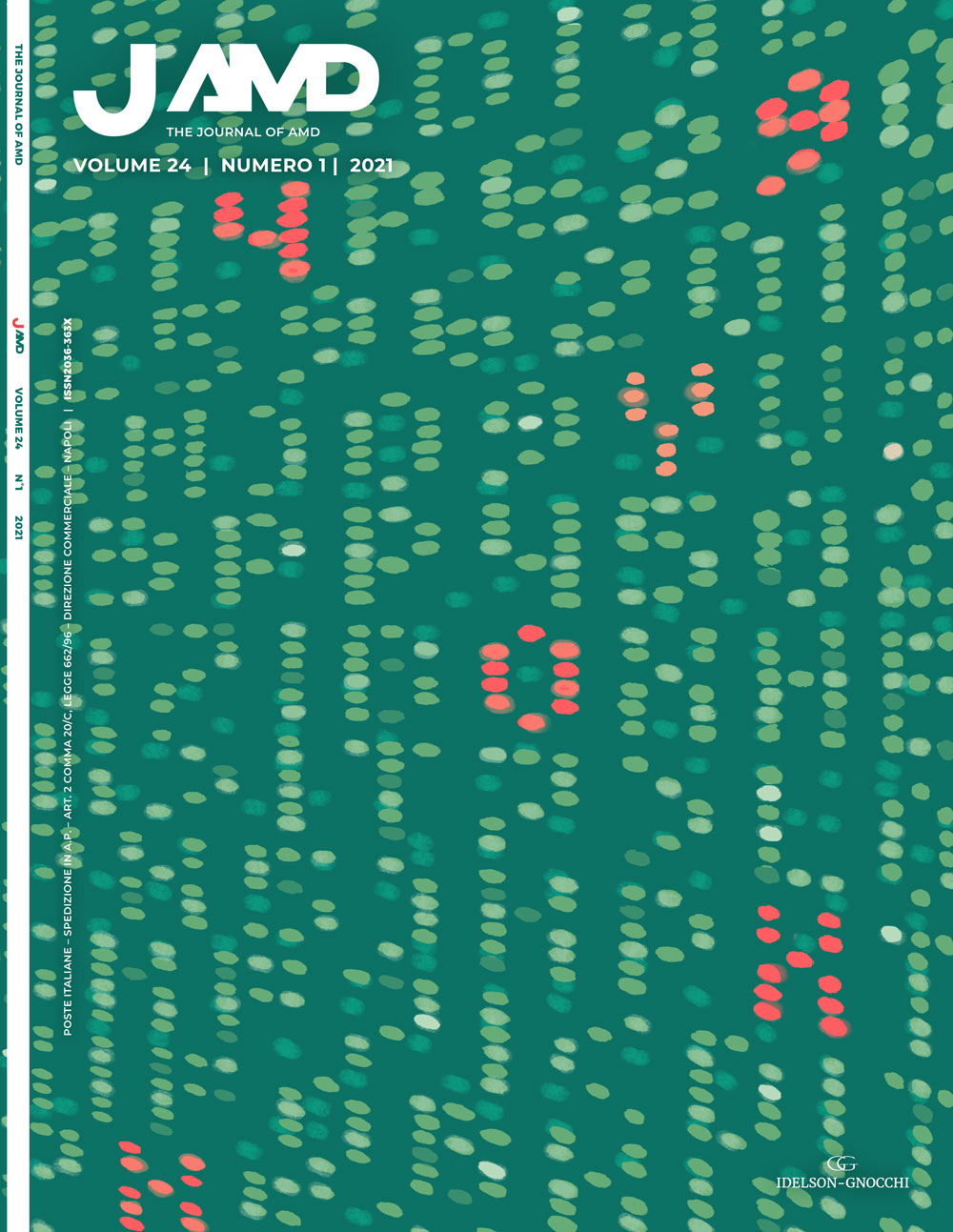Original articles
AMD Annals 2020 – Synopsis on Type 1 Diabetes. Evaluation of AMD quality indicators of type 1 diabetes care in Italy
JAMD 2021;24(1):6-18
STUDY OBJECTIVE This new edition of the “Annali AMD” aim to show how T1DM quality care has evolved two years after the last evaluation.
DESIGN AND METHODS The processing regards data of 34705 patients, involving 258 centres and referring to data updated to 2018. Our data concerns socio-demographic and clinical characteristics of patients as well as the volume of activity. The indicators selection is based on a consistent share of the current Indicator List adopted – Revision 8 of 19 June 2019, available on the AMD Annals website.
RESULTS The amount of new diagnoses is confirmed at 3%, while first accesses has increased to 7.3%. Gender distribution shows a slight prevalence for males and there is an increase in the adult and elderly population. Data shows a general improvement in monitoring of main clinical parameters, specifically albuminuria monitoring (+13.4%). Among favourable outcomes stands out the share of patients with C-LDL <100 mg/dl (+4.2%), offset by the slight reduction of subjects with T1DM and blood pressure at target level. (-1.3%). We observed a trend of continuous improvement with regard to HbA1c, C-LDL, micro/macroalbuminuria and smoking. The proportion of patients with reduced GFR has increased by 4 % compared to the 2018 Annals. The slight increase of subjects with high blood pressure and high BMI deserves a closer attention. The share of subjects treated with CSII has increased from 12.6% to 18.1% over two years, reflecting the increasing access to the use of technologies for T1DM care. In addition, the percentage of subjects in lipid-lowering treatment increased from 30.4% to 34.5% while the percentage of subjects treated with at least one antihypertensive drug remained stable. The prevalence of chronic complications is still underestimated, however current indicators show a trend of increased prevalence of myocardial infarction and history of cardiovascular disease.
CONCLUSIONS A comparison of population distribution by score class Q shows that the proportion of subjects with Q < 25 scores has fallen further over two years and, at the same time, the share with a score Q of between 25 and 40 has increased, a significant sign of an improvement in the overall quality of care.
KEYWORDS type 1 diabetes mellitus; AMD indicators; quality of care; AMD Annals.
AMD Annals 2020 - Synopsis on Type 2 Diabetes. Evaluation of AMD quality indicators of type 2 diabetes care in Italy
JAMD 2021;24(1):19-29
OBJECTIVE OF THE STUDY The AMD 2020 Annals on Type 2 Diabetes (DM2) set out to show, 2 years after the last evaluation, how the quality of DM2 care has evolved in Italy.
DESIGN AND METHODS In order to participate in the initiative, the centers had to be equipped with information systems capable of guaranteeing the standardized extraction of the information necessary for the creation of the AMD Data File. The data analyzed concern socio-de-mographic and clinical characteristics and volume of activity. The selection of indicators is based on Revision 8 of June 2019 (AMD Annals website).
RESULTS DM2 patients increased to 473,740 (57.1% M; 42.9% F, 67.4% aged> 65 y). 6% new diagnoses. All monitoring indicators, of favorable and unfavorable outcome, have improved: 52.9% of DM2 have HbA1c levels <= 7.0%(53 mmol/mol), 63.5% have LDL cholesterol values <100 mg / dl, 53,5% have blood pressure levels <140/80 mmHg, 39.9% are obese. The proportion of patients with GFR <60 mL/min*1.73 m2 rose to 29%, and 7.1% had GFR <30 mL / min. Therapy: there is a reduction in the use of sulfonylureas and glinides (19.9%); stable use of insulin; new drugs are increasingly prescribed (DPPIVi:21%; GLP1-RA: 5.9%; SGLT2i: 9.6%). 60.8% are on lipid-lowering treatment, 70% are on antihypertensive therapy, but 48.6% are not on target. Complications: 22% have diabetic retinopathy; 7.5% had myocardial infarction, 2.7 had a stroke, 14.7% had a history of cardiovascular disease. 50.8% of subjects with age>75a have HbA1c levels <= 7.0%(53 mmol/mol), of these 16.3% are treated with drugs that can induce hypoglycemia. Patients with Q Score> 25 are growing (60.3%).
CONCLUSIONS The AMD 2020 Annals on DM2 show a marked improvement in all indicators of quality of care, but large areas of undertreatment and other overtreatment remain, and call to action.
KEYWORDS AMD Annals; type2 diabetes mellitus; quality of diabetes care in type 2 diabetes patients in Italy; undertreatment; overtreatment.
Patterns of care of subjects with type 1 and type 2 diabetes according to their cardiovascular risk
JAMD 2021;24(1):30-38
AIM OF THE STUDY To explore the distribution by cardiovascular risk groups according to the classification promoted by the ESC (European Society of Cardiology) of subjects with type 1 (T1D) and type 2 (T2D) diabetes cared for by Italian diabetologists and to describe the quality indicators of care, with particular regard to cardiovascular risk factors.
DESIGN AND METHODS The study is based on data extracted from electronic medical records of patients treated at the 258 diabetes centers participating in the Annals AMD initiative and active in the year 2018. Patients with T1D or T2D were stratified by cardiovascular risk, in accordance with the recent ESC guidelines. General descriptive indicators and measures of intermediate outcomes, intensity/appropriateness of pharmacological treatment for diabetes and cardiovascular risk factors, presence of other complications and overall quality of care were evaluated.
RESULTS Overall, 29,368 adults with T1D and 473,740 subjects with T2D were evaluated. Among subjects with T1D: 64.7% were at very high cardiovascular risk, 28.5% at high risk and the remaining 6.8% at moderate risk. Among subjects with T1D at very high-risk: 54.7% had retinopathy, 29.0% had albuminuria, 7.3% had a history of major cardiovascular event, 47.3% had organ damage, 48.9% had three or more risk factors, and 70.6% had a diabetes duration of over 20 years. Among subjects with T2D: 78.5% were at very high cardiovascular risk, 20.9% at high risk and the remaining 0.6% at moderate risk. Among those with T2D at very high risk: 39.0% had organ damage, 89.1% had three or more risk factors, 18.7% had a previous major cardiovascular event, 26,4% had retinopathy, 39.5% had albuminuria. With regard to the glucose-lowering drugs: the use of DPPIV-i increased markedly as cardiovascular risk increased; the use of secretagogues also increased and, although within low percentages, also the use of GLP1-RA tended to increase. The use of SGLT2-i is also still limited, and only slightly higher in subjects with very high cardiovascular risk. In both types of diabetes, the overall quality of care, as summarized by the Q score values, tended to be lower as the level of cardiovascular riskincreased.
CONCLUSIONS The analysis of a large population such as that of the AMD Annals database allowed to highlight the characteristics and quality indicators of care of subjects with T1D and T2D in relation to cardiovascular risk classes. A large proportion of subjects appear to be at high or very high risk.
Glucose-lowering drug therapies seem not to be adequately used with respect to the potential advantages in terms of reduction of cardiovascular risk of some drug categories (GLP1-RA and SGLT2-i) and, conversely, with respect to the potential risks related to the use of other pharmacological classes (sulfonylureas). Several actions are necessary to optimize care and improve the quality of care for both subjects with T1D and T2D.
KEYWORDS type 1 diabetes; type 2 diabetes; cardiovascular risk; quality indicators of care.
Telemedicine and digital narrative medicine for the customization of the diagnostic-therapeutic path at the time of COVID 19
JAMD 2021;24(1):39-45
The Covid-19 issues have placed the telemedicine into the limelight, for its ability to reach remote patients affected by COVID-19, offering them support, expert advice, home hospitalization. At the same time, it gives the many fragile patients, who should be submitted to therapeutic checks or adjustments, the opportunity to be followed appropriately, avoiding travelling and associated risks of contagion.
The current situation has accelerated its use in diabetological care: but with the risk of reducing the medical-patient empathic relationship.
Narrative Medicine (NBM) integrates with Evidence-Based Medicine (EBM) and, taking into account the plurality of perspectives, makes clinical-care decisions more complete, personalized, effective and appropriate. The stories told by patient and by those who take care, are an essential element of contemporary medicine, based on the active participation of the subjects who are involved in the choices. People, through their own stories, become protagonists of the process of care”.
The ability of mixing the technology achievements with the humanistic vision of the care process characterizes DNM, the first digital platformentirely designed for the development of narrative medicine projects in the clinical practice. It was conceived by a team of anthropologists and psychologists with the advice of doctors and experts in narrative medicine of OMNI the Observatory of Narrative Medicine Italy.
The DNM features aim to maximize the potential of the digital process, at the same time preserving patient privacy and health data confidentiality.
KEYWORDS telemedicine; narrative medicine; digital narrative medicine.
Punto di vista
Beyond the Covid-19 emergency. The evolution of our National Health Service
JAMD 2021;24(1):46-53
The emergency created by the spread of COVID-19 has lead to a wide spread awareness of the central role of the health policies. Certainly it seems to be essential that the scientifically based monitoring of the health sector should persist and carried through the participation of Medical-Scientific Associations which are the real bearers of the experience lived daily, especially considering the forthcoming arrival of a conspicuous amount of European financial funds: the Italian health system, and the whole country, certainly cannot afford to miss the opportunity for a radical modernization of their infrastructures, according to the current Parliament debate. The Recovery Fund will be a great opportunity and responsability to reform our public machinery, planning how renovating our NHS. Looking at the next 10 years, taken for granted the Mission of our NHS is the Vision will need to adapt to future social needs. Healthcare must not be a sector which consumes a substantial proportion public expenditures but an investment for growth. Effective planning requires to be preceded by a strategic vision, in order to define the objectives to be pursued and therefore the key performance indicators to measure effectiveness. Bridging the health inequalities that still persist in the country: this must be the priority in the use of resources and make the universalism of the NHS effective for all Italians, in the same way throughout the country. The role of the “territory” is fundamental. A profound reflection is needed on the relationship between hospital and territory: it no longer makes sense to think of the two categories in alternative terms. The main obstacle to strengthening the “territory” is the lack of shared organizational models. The evolution and refinement of technological knowledge with the increasing spread of telematic “networks” and computer hardware, together with demographic and morbidity changes, require a rethinking of the methods of providing care. In some conditions – for example in chronic diseases such as diabetes mellitus – technological aid could be the solution to allow the adequacy and appropriateness of treatments in conditions of maximum safety. This is the time to define specific treatment paths that are the new references for the definition of tariffs by reviewing the tariff nomenclator (LEA Review), and to overcome the rigid logic of prescription and reimbursement of individual services (Essential Path Levels, LEP). This model would respond more precisely to the needs of a “patient-centered medicine”, recognized by both the National Diabetes Plan and the Chronicity Plan as the most effective care models for managing chronicity, capable of safeguarding and protecting the patient in the long term, preventing acute situations and ensuring real responsibility for the healthcare professionals concerned. The development of a new organic model of taking charge of the patient with Diabetes, also thanks to the introduction of telemedicine and tele-assistance, provides an all-in-clusive rate of the enteire path/process, including different services in different specific conditions – for example diabetic foot, diabetes in pregnancy, the implantation of insulin pumps –. We must un- doubtedly invest not to maintain the status quo, we cannot afford only about recovering the losses due to the pandemic COVID-19 crisis, we must move on from the past and create the conditions for a transition towards a health service model for the future.
To do this, it is necessary to have a structured vision, which can only be built with a choral contribution of ideas: effective and efficient programming is that which starts from a vision of the system and from a long-term stabilization of the state financing.
KEYWORDS COVID-19; national health service; flexibility; resilience; recovery fund.
Consensus document
Treatment of Diabetic Ketoacidosis (DKA) and Hyperglycemic Hyperosmolar State (HHS): management in emergency area
JAMD 2021;24(1):54-63
The treatment of hyperglycemia is a common issue among physicians, especially those working in the Emergency-Urgency departments. The aim of this study is to suggest a practical and immediate Operating Protocol for the management of hyperglycemia in this context.
This protocol was created by the inter-society AMD-SID-SIEDP-SIMEU-SIMEUP project group set up in the Lazio Region and subsequently subjected to validation by the AMD Diabete e Inpatient Project Group. The multidisciplinary working group, after examining the literature available on PubMed, selected the most recent bibliographic sources suitable.
We created this operating protocol that allows a rapid differential diagnosis of four possible scenarios (moderate/severe hyperglycemia; hyperglycemia and ketosis; hyperglycemia and ketoacidosis; hyperglycemia and hyperosmolarity) and, thanks to the quickly available flow-charts, it represents a rapid therapeutic choice for the physicians. We underline the most important lab tests to be performed and monitored and we focused, indeed, on the goals to be achieved when the patient is ready to exit the protocol. The flow charts were designed to be printed and used in the Emergency Area for quick reference.
The proposed operating protocol is an attempt to simplify the therapeutic protocols present in literature for the management of hyperglycemia in the emergency setting, based on both the experience, the needs and the habits of ER physicians and diabetologists. The correct management of hyperglycemic emergencies undoubtfully leads to a reduction in patients’ morbidity and mortality and consequently to a reduction in global healthcare costs, so that we strongly believe the usefulness of this protocol.
KEYWORDS diabetic ketoacidosis; hyperglycemic hyperosmolar state; management of hyperglycemic crises; emergency area.
Surveys
Approach toward diabetic nephropathy and its management in patients with type 2 diabetes: results of a web-based italian survey
JAMD 2021;24(1):64-71
AIM The purpose of this survey was to investigate the attitudes and clinical approach of Italian diabetologists toward diabetic nephropathy (DN). METHODS A 28-item web survey was distributed to Italian diabetologists by the Associazione Medici Diabetologi. The first part of the questionnaire was aimed at describing the sample of clinicians involved (age, gender, practice setting, etc.). The second part analyzed more deeply the clinical approach to DN.
RESULTS Two hundred and thirty-five clinicians, expert in the field (over 44% have been working as diabetologists for more than 20 years) and well distributed across the country, participated in the survey. The lack of medical care provided from a team remains a main concern, since only in a minority of diabetes centers diabetologists can collaborate with health professionals with expertise and a special interest in diabetes. Screening of DN is performed at first visit by 95% of participants. Urinary albumin creatinine ratio and estimated glomerular filtration rate by CKD-EPI are two approaches used. The relevance of intensive glycemic treatment respect to the onset and progression of DN is mostly considered in patients with microalbuminuria, less frequently in patients with more advanced kidney disease. Almost the totality of participants prescribes renin angiotensin system blocking drugs for the treatment of hypertension, mainly in presence of albuminuria. This class of drugs is less frequently recommended in normotensive patients with microalbuminuria. Regarding the new anti-hyperglycemic drugs, more attention is paid for SGLT2 inhibitors or GLP-1 receptor agonist.
CONCLUSIONS The present survey highlights the clinical relevance of DN and the high attention for this diabetic complication by Italian diabetologists. Although the lack of medical care provided from a team remains a main concern, the diabetologists are engaged in promoting educational and screening programs. They are also in keeping with guidelines in choosing antihypertensive treatment or new antihyperglycemic drugs showing to protect kidney function. Finally, participants to the survey declare that they are willing to collaborate with nephrologists, mainly in the more advanced stage of DN.
KEYWORDS diabetes mellitus; chronic kidney disease; SGLT2 inhibitors; GLP-1 receptor agonist; diabetic nephropathy.
Attività dei gruppi
Gruppo Medicina di Genere – Gender Medicine Workgroup
Metformina: farmaco vecchio, ma molto galante…
JAMD 2021;24(1):71-73
Il significato della medicina genere-specifica nei percorsi di salute e di malattia
JAMD 2021;24(1):74-80




